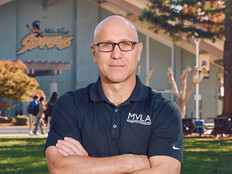Because of the changing operations, school leaders and IT professionals may need to adjust normal safety procedures and systems. To keep people safe during all campus activities, Bliesner recommends reviewing school safety policies in light of each changing operational status and communicating appropriate procedures for each activity. For example, if the varsity football team is holding a camp for middle school football players, or the district’s science teachers are holding a science camp for elementary students, school leaders should determine the safety procedures in advance for each one.
“Consider the risks for each activity and determine in advance what should happen, depending on the circumstances,” Bliesner says. Every involved adult should know the process for pickup and drop-off, the procedures to follow in case of emergency, and how to use safety technology such as public address systems and emergency systems.
“Schools are public buildings and are the heart of many communities,” he says. “Be aware of how your building is being used, and factor that into your safety and security plans.”
DIVE DEEPER: How does technology support the Incident Command System?
Prepare Buildings and Technologies for a Safe School Year
In addition to maintaining safety throughout the summer, these months are also a good time for schools to consider auditing and upgrading safety technologies. Although buildings are likely still in use during the summer, they’re not as busy as during the school year, which makes it a good time to undertake safety projects that may be more difficult when buildings are full all day.
“The summer presents an ideal time for leaders and IT professionals to audit and take an inventory of the systems in place, safety processes and infrastructure,” says Gary Shay, director of product management at Johnson Controls, a provider of building infrastructure and security products and services. Shay recommends bringing in a third-party provider to conduct a comprehensive safety and assessment audit, providing clear recommendations to consider for an action plan. Working with a knowledgeable vendor can also help ensure compliance with evolving regulations.
During the summer months, Bliesner recommends making safety updates, such as adding visibility management software or portals to electronic access control systems. However, it’s best if changes like those can happen when buildings are not in use.
“Consider combining activities on a single campus and rotating summer activities to another campus halfway through the summer to work on updates,” Bliesner says. “I’m a fan of placing new cameras or making other updates when nobody’s using the building. In districts that don’t have multiple campuses, it’s best to avoid using the building for two weeks to manage the updates.”
Not only should school technology leaders use summertime to undertake necessary security updates, they also should use this time to try out various safety technologies, Shay says. During the school year, the building may be too busy to pilot a new entryway system, for example. But in the summer, schools can take a trial run on a new system and see if it works before rolling it out with a full school population.
LEARN MORE: Missouri equips mobile incident command centers for school safety.
Finally, if school technology leaders are thinking about adding other systems, “the more idle summer period can offer an opportunity to tour other school campuses where new solutions and technologies are in place already,” Shay says. Taking the time to see the technology in action can help school stakeholders plan for future upgrades and retrofits.
School may be out for summer break, but school safety never stops. Use this period as a time for rethinking procedures and updating systems to ensure campus safety through the summer and beyond.











